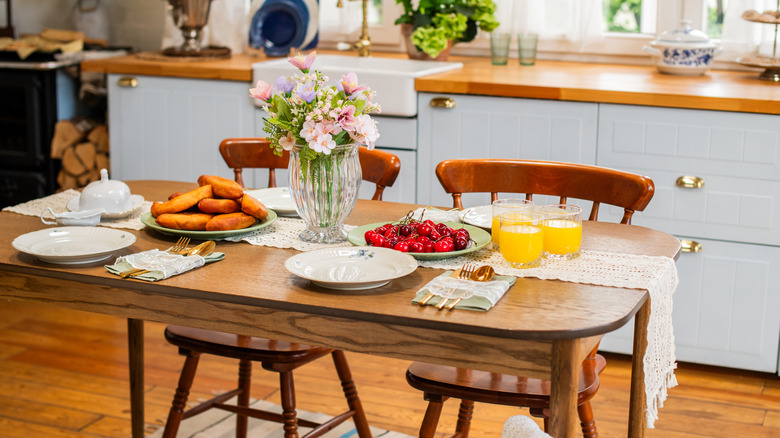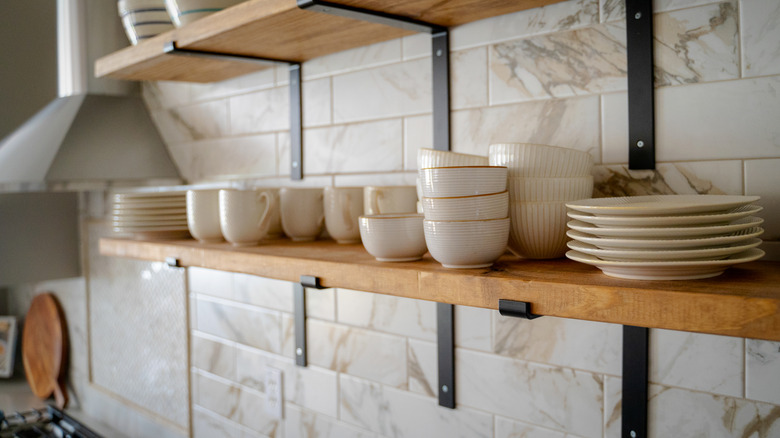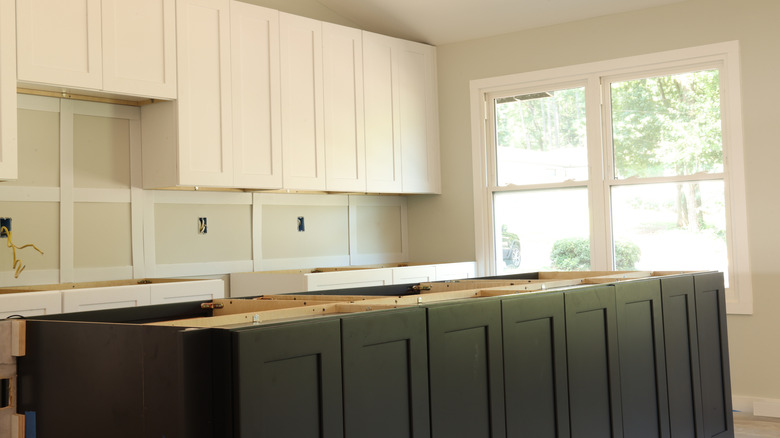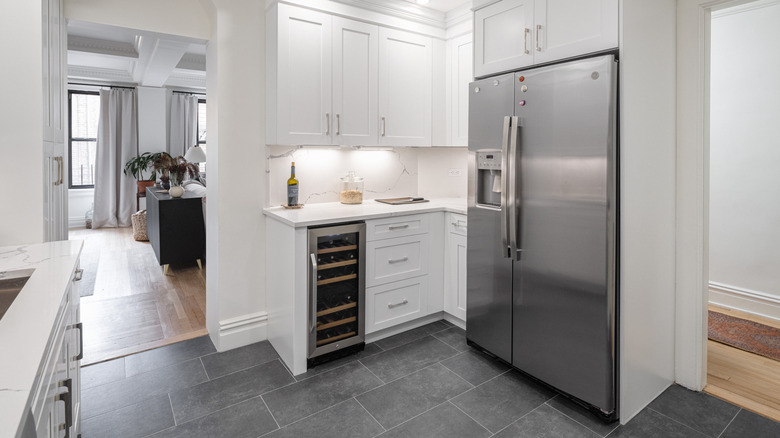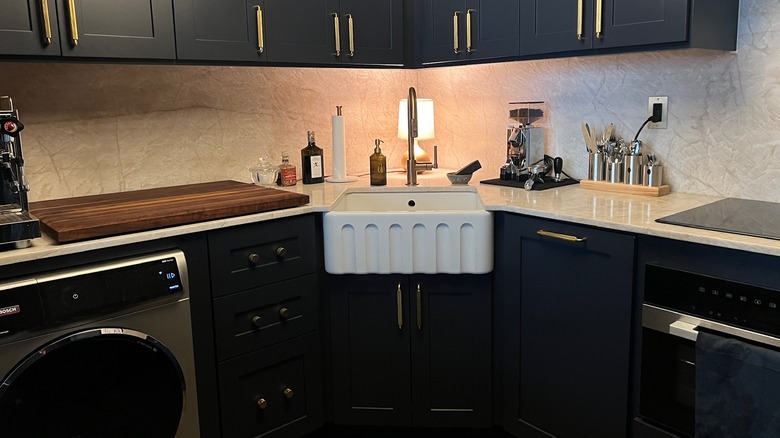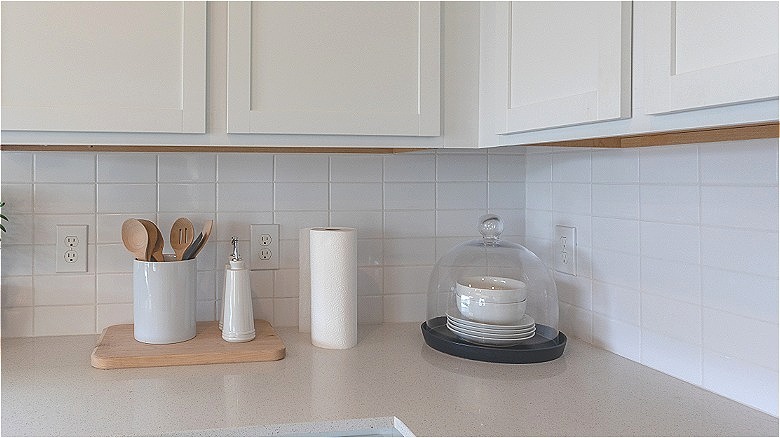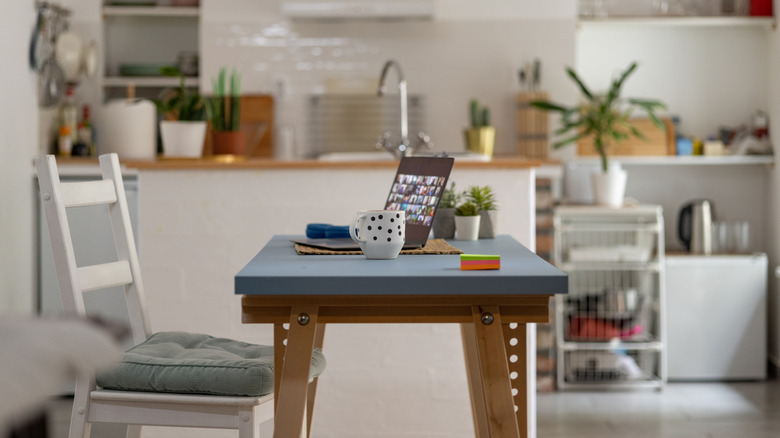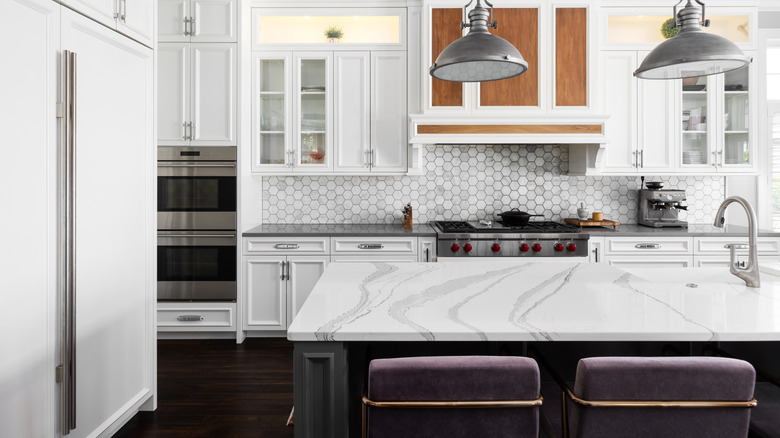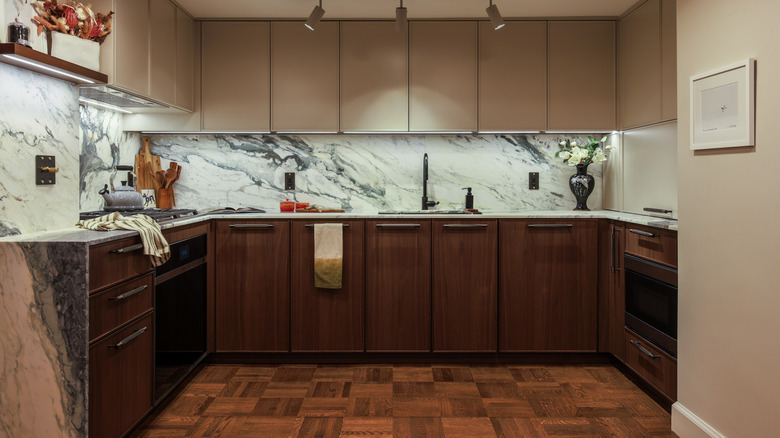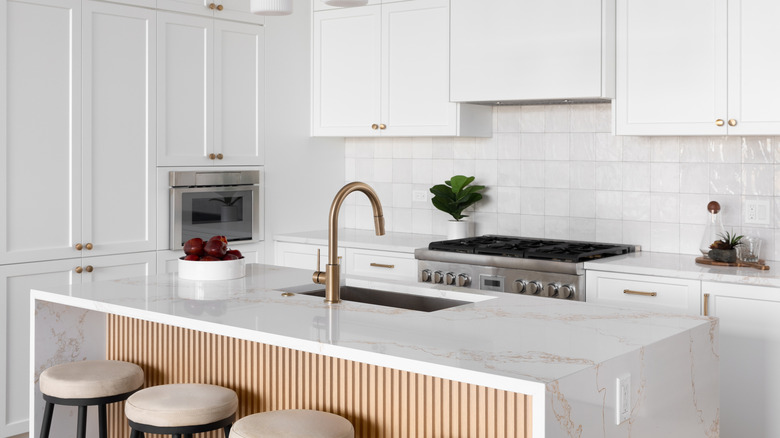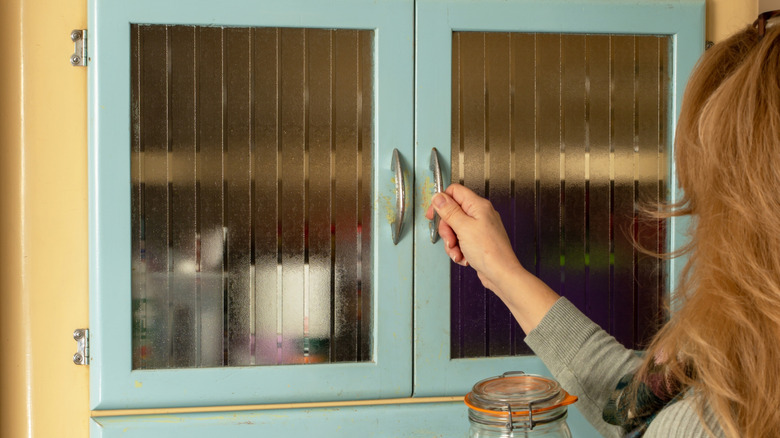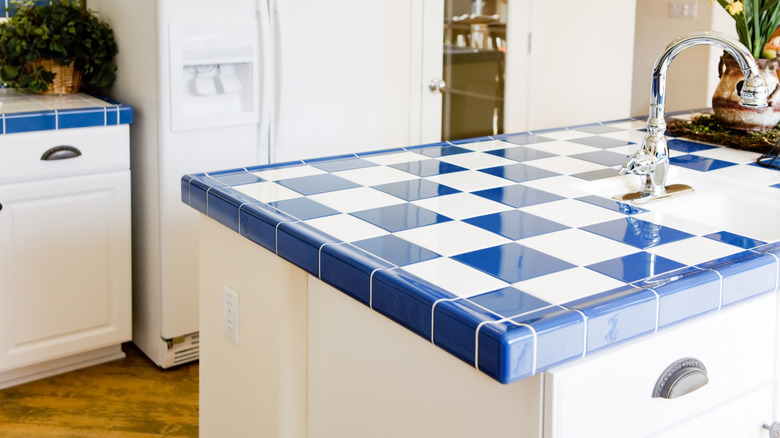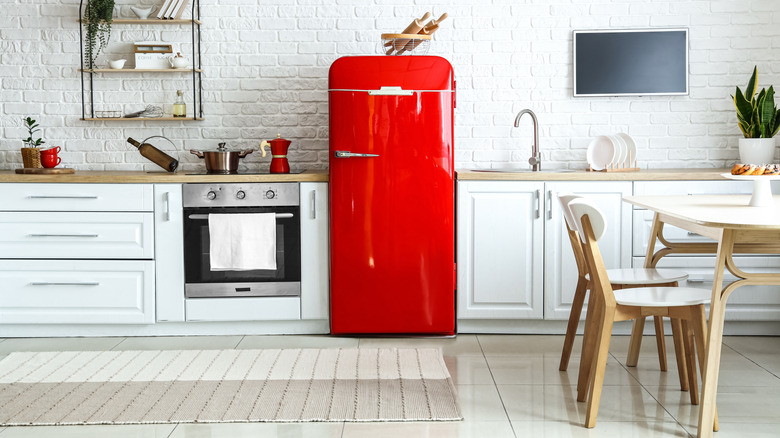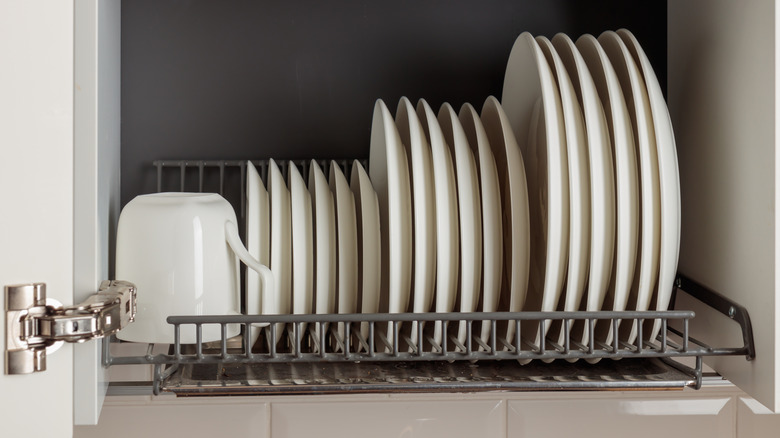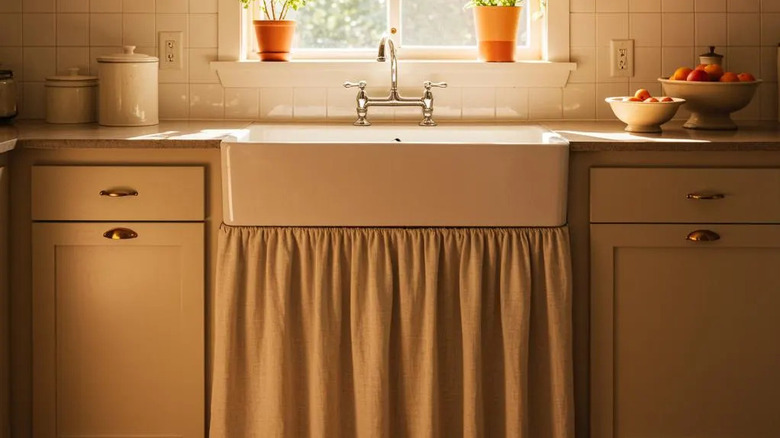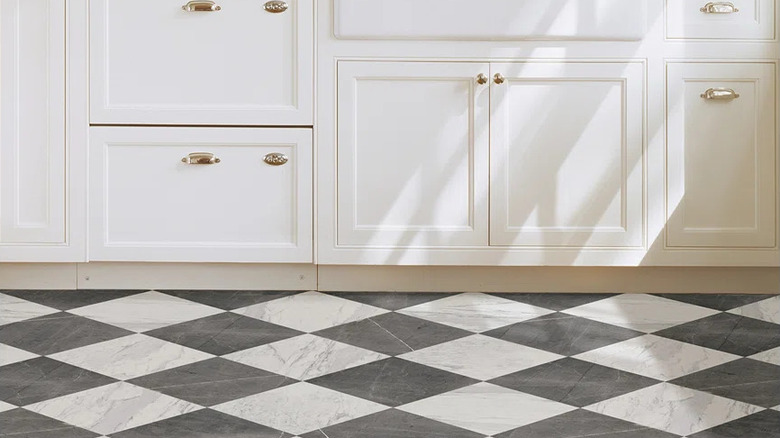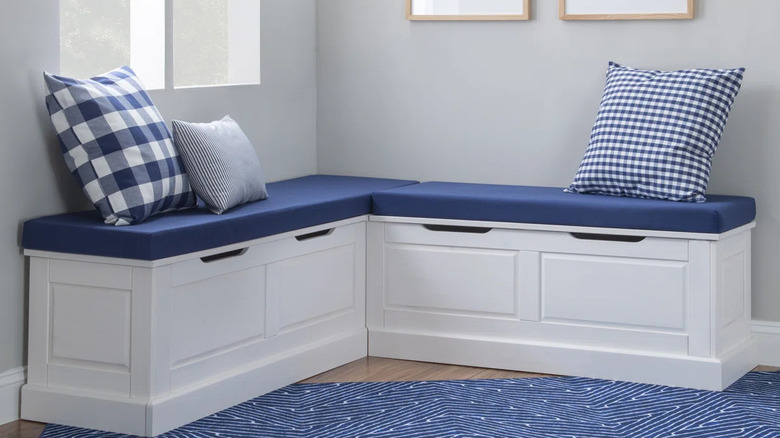16 Outdated Kitchen Features That Are Unexpectedly Coming Back In Style
Kitchen trends come and go, but inevitably, what's en vogue always tends to loop back around! In this House Digest exclusive, we spoke to top designers, home renovators, and real estate agents about which outdated kitchen features are unexpectedly coming back in style. So whether you have always loved open shelving and are never sure if it's "in" or not, or enjoy your dark, rich kitchen cabinets and don't want to get rid of them — this is for you.
Our experts explain how these trends have improved, leading them to regain popularity. They share how to style them so they last much longer this time around, and how to make them feel fresh, rather than dated. Whether you're planning a full kitchen remodel or just want to refresh a few key details, these revived classics prove that great design never truly goes out of style.
Open shelving is always a great decoration tool
Open shelving is one of the outdated trends that HGTV's Property Brothers swear are ruining your home's vibe. However, many designers disagree with this take, stating that, actually, the feature is so back. "Open shelving got really big in the 1980s, and has been on again and off again in terms of popularity ever since," Courtney Cole, interior designer at TileCloud, tells House Digest exclusively. "Right now, I think open shelving is back in — giving the room an open and airy feeling when you keep them clutter-free."
To keep the streamlined look, carefully consider what you store on the open shelves in your kitchen. While piles of mismatched plates and cups might not be the move, a uniform stack of dinner plates with the same diameter, a set of mugs, or larger items like mixing bowls or kitchen appliances can work better. "They can also be a great decorative accessory when you style them well — especially with trinkets like plates and plants," Cole adds.
Tone-toned cabinetry is an easy way to experiment with color
Adding visual interest to kitchens with one-dimensional cabinetry can be difficult. These single-color options typically feel flat, which is why two-toned variants are on their way back in. "I'm seeing a rise in two-toned kitchen color palettes. This went out of fashion a few years ago with cabinetry, but I think it's backing a comeback," Cole shares. "People are now using a neutral base with a darker island to add more depth to the kitchen space."
If you aren't too sure about experimenting with color, Cole says this is a great way to do so "without making it too obvious." And luckily, this design choice is never too permanent. "The benefit here is also that if you don't like it, you can easily paint over it," Cole continues. If you do decide to paint, be sure to check out the gorgeous color everyone will be painting their kitchen cabinets in 2026: butter yellow, and example of which is Magnolia Home's Heirloom Yellow.
Semi-separated living areas are replacing open concept homes
If there is one feature that has been consistent in American kitchens, it's the open concept, or kitchens that seamlessly flow into the living/dining areas — but not any more. "Open concept had a solid 20-year run, and while it's not disappearing completely, homeowners are rethinking the need for distinct zones," Dorothy Weise, interior design department lead at Chapter, tells House Digest in an exclusive interview. "Total openness is being replaced by soft separation."
Weise shares that "compartmentalization is making a comeback, not as a replication of the traditional chopped-up homes of the past, but as a way to create balance in today's multipurpose households." She suggests adding reading nooks or a purpose-built WFH area. You could even design a breakfast niche that is set back from the rest of the space to create separation. Whatever you choose, she insists the best applications are when "the design maintains a semi-open circular flow that offers a bit of privacy without fully closing off space."
The return of brass and the end of Euro-clinic kitchens are trending
Those looking for a guide to Japandi style and how you can use it in your home might need to think twice, as the sterile, minimalist vibe of this movement is beginning to wane in popularity. "The ultra-minimal, Euro-inspired kitchen, all sleek panels and hidden appliances, is starting to feel a bit clinical," Weise tells House Digest readers. Instead, warmer, more homey feeling spaces will soon be the dominant trend. "Brass and warm-toned metals are making their way back into fixtures, hardware, and lighting," she continues. "These finishes add a layer of richness and patina that stark black or chrome never quite captured."
Luckily, swapping out hardware is one of the easiest affordable ways to freshen up a cold millennial gray kitchen. For example, the KRAUS Oletto Pull Down Kitchen Faucet in brushed brass is roughly $340, and its installation is an easy DIY project. You can also easily swap other accents around your kitchen, like the Amerock Rubbed Bronze Plate Cover, for a quick update to any light switches.
Corian countertops are making a comeback
The most durable kitchen countertops are quartz, granite, and Dekton, but man-made options are giving them a run for their money, according to our experts. "Solid surfaces like Corian and high-end laminates, once considered the budget option, have gotten a facelift," Weise says. "These materials are being re-embraced for kitchens, bathroom vanities, and utility areas, thanks to their seamless appearance, zero grout lines, easy maintenance, and surprising durability."
In the past, some considered these materials cheap or fake; however, the updated options are plenty chic. "Modern versions come in sophisticated colors, stone-like textures, and even integrated sink designs, all of which offer a sleek, hygienic alternative to tile or natural stone, especially in high-use areas," Weise continues. Beyond just looks, homeowners appreciate Corian's practicality. It tends to resist stains and bacteria, making it a smart pick for busy families. It's also repairable, meaning surface scratches or wear can be sanded out to keep it looking new for years. The manufacturer recommends 240 Grit Wet/Dry Sanding Paper or 60 Grit Wet Dry Sanding Sheets to get the job done.
Kitchen desks are no longer dated and are being welcomed
In a digital world, many analog tasks around the house are becoming obsolete. However, the spaces facilitating these tasks are unexpectedly coming back in style. "Once a staple of traditional homes and often tucked into a corner, the kitchen desk was where checkbooks were balanced, calendars updated, and recipes handwritten," Weise advises about the feature that's seeing a resurgence. "That idea is back, albeit in a more flexible form."
During the pandemic, as WFH became the new normal, these once-abandoned stations returned to vogue. "Designers are reincorporating built-in workstations into kitchens, a response to the post-pandemic need for multiple work zones in the home," she continues. "Think small writing desks, charging stations, or millwork nooks that serve as functional, low-commitment home offices." However, you don't need to complete a total kitchen redesign to hop on this trend. For example, the Lufeiya Small Computer Desk has a wood grain that can complement many kitchens, while its compatct dimensions make it a good fit for most spaces.
Exposed appliances can look just as luxe as panel-ready options
After years of minimalist, fully integrated kitchens, the pendulum is swinging back. Visible appliances are being treated as design statements in their own right, not just as something to hide."For years, the goal was to hide the appliances: panel-ready everything to be disguised as cabinetry," Weise says. "But now, slide-in appliances, boasting stainless steel, matte black, or modern white finishes, are being shown off once again." The trend speaks to the larger shift back towards imperfect, live-in spaces, instead of showroom-ready kitchens.
That said, consider integrating exposed pieces thoughtfully. For example, you can pair a brushed brass faucet and cabinet pulls with a matte white range for contrast, or echo a black stainless fridge with dark window frames or barstool bases. If doing a renovation or designing from scratch, opt for slim, counter-depth models to maintain clean sightlines, and use a matching vent hood or appliance handles to tie the look together. Weise also adds that designing things this way is easier for overall maintenance, too. "It's easier to replace or upgrade without a custom panel every time," she says. "Plus, it's more budget-friendly and offers a wider range of models."
Deep wood tones are starting to feel daring instead of dated
In addition to two-tone cabinets becoming popular, the color of the wood used is also rapidly changing. "White oak has been the darling of design for well over a decade, but designers and homeowners alike are now craving richer, deeper wood tones once again," Weise says. If you're looking for inspiration, she has plenty: "think walnut, mahogany, cherry, and even stained oaks." Just like repainting, restaining lighter cabinets to these deeper colors is an easy DIY project. A rich stain, like Minwax PolyShades Wood Stain + Polyurethane Finish in Bombay Mahogany, will do the trick.
Weise says that these colors are regaining popularity because of the overall shift back to familiar, lived-in spaces instead of sterile, minimal spaces. "These woods bring warmth, contrast, and a sense of permanence to interiors. Whether it's through cabinetry, millwork, or furniture, darker woods are making spaces feel cozy, grounded, and timeless." In general, she believes these deep tones offer a welcome alternative to many for the bleached options of late.
Wood paneling is being implemented with contemporary touches
You might think "Brady Bunch" or "Graceland" when you think of wood-paneling in kitchens, but the resurgence of this trend is taking a lighter, brighter stance on the design. "One thing that is coming back: wood paneling, although not the kind associated with the 1970s," Jacob Naig, owner & real estate investor/agent at We Buy Houses In Des Moines, shares exclusively with House Digest. "Rather than using heavy, dark paneling to overpower spaces, designers now apply lighter stains and arrange pieces vertically to introduce warmth and texture in kitchens ruled by stone and steel."
Naig also recommends updating any existing wooden panels that might be stuck in the '70s to match the modern trend, instead of getting rid of them. "I also have restored walnut panels on mid-century homes alongside modern quartz counters and the effect is so nostalgically new old," he says. "The key, of course, is to moderate — wood as an accent wall or island paneling rather than the whole room." For a simple refresh, you can also try wrapping a kitchen island or portions of the wall in slats, like the Art3d Slat Wood Wall Paneling, which can be cut to size. This can introduce the look without overwhelming the space.
Larders are making a resurgence
Old-fashioned no more, larders are returning as a chic, practical alternative to oversized pantries. "Walk in pantries have been the norm for many years now but free standing or built in larder cupboards are back, particularly when space is at a premium in smaller homes," Naig shares. "These bring the charm of farmhouse kitchens to your home while offering contemporary storage options."
To make a larder really work for you, Naig recommends painting the larder a crazy, bold color and using brass hardware to complement the tones. If you need any convincing, HGTV star Joanna Gaines has a tip for embracing bold paint colors: Start small! Her tip goes hand-in-hand with Naig's. If you only paint the door of the larder a bold hue, while leaving the rest of the kitchen cabinets and walls relatively neutral, you can add some playful visual interest without completely overwhelming the space. For hardware, try the Asidrama Antique Brass Kitchen Cabinet Handles, which have enough rustic charm to fit the farmhouse aesthetic.
Tile countertops are low-key trending
Certain HGTV stars, like the Property Brothers, cannot stand this '80s kitchen trend! Yet our experts insist that the reasons the Scotts don't like tile countertops in kitchens are no longer valid, as there are many modern improvements to the medium. "Tile countertops, which have long been abandoned for being dated and hard to care for, also are making a comeback in places," Naig says. "Improvements to grout technology have resolved many of these old problems and designers are including handmade tiles that lend personality."
Naig does warn, however, that tile countertops still might not be for everyone. "While many people wouldn't do this on the home front, in artful or eclectic kitchens, the impact can be unforgettable," he says. Once you decide on tile, choosing the right type of tile is the next step. For example, while zellige tiles are gorgeous and trendy, they're a tile that's not worth buying for a high-traffic space like a kitchen countertop, because they are delicate. While you can use them for a backsplash paired with a stone countertop, porcelain tiles are a touch more sturdy and can be a better fit for countertops.
Colorful appliances are cool again
Goodbye, stainless monotony and hello to color! Designers are leaning into hues that make the kitchen feel personal again, rather than the sterility of silver. Personality is back! "Colored appliances are returning after years of domination by stainless steel. It is being balanced with soft pastel, chalky finishes and the low sheen of deep greens to add personality and warmth," Naig says. This trend speaks to the growing shift towards lived-in spaces with personality.
In the 1950s, there was a color revolution, as the kitchen was a bright, homey space filled with bright hues across appliances, like pastel pinks and buttercream yellows. This bright, cheerful take on cooking spaces is back. "They are most well-suited to transitional kitchens where homeowners desire a unique signature and not just another cookie cutter stainless set-up," Daig continues. "I've seen that yuppie, younger buyers seem to be drawn towards those choices in Des Moines and treat appliances almost like furniture." You don't have to travel far to find them, either. The Home Depot sells the Unique Appliances Classic Retro Fridge in a mint green, while Wayfair sells the Unique Appliances Classic Retro Freestanding Gas Range with Oven in robin egg blue.
Plate racks are popping back up
Recent kitchen trends have prioritized hiding clutter to create a uniform, almost industrial look in the space. Yet another outdated feature that's back in vogue as homeowners begin to embrace the mess is the plate rack. "Plate racks are once again putting everyday dishes on display," Vanessa Larsson, interior designer at Planner 5D, tells House Digest exclusively. "For long this felt dated, however, with the rise of modern farmhouse and vintage aesthetics, they are once again a charming and practical feature."
Plate racks don't need to be built in to work well. It's easy to find free-standing options online, like the INNERNEED Bamboo Wooden Plate Rack, or the SIMPLE HOUSEWARE Vertical Plate Stand Holder, which is made of steel for a different look. For decorative plates, consider the Skwelom Bamboo Tiered Display Stand, as its slightly raised profile makes it easier to see each item at once.
Sink skirts have suddenly become stylish again
When decorating your kitchen for this year or beyond, our experts insist that you don't need to be afraid of texture and using it to create a little bit of whimsy. "Another vintage and farmhouse detail making a quiet return is the sink skirt," Larsson says. "Once rarely seen, this charming touch softens the hard lines of a kitchen while cleverly concealing bins and cleaning supplies. Whether in a rustic cottage or a Victorian-era space with a touch of Renaissance romance, it brings a layer of warmth and softness."
For the crafty, knowing how to make a DIY sink skirt for rustic charm will be a no-brainer and a fun way to spend a Saturday. However, even if you don't know your way around a sewing machine, you can nab a pre-made option — like this Red Striped Cotton Sink Skirt on Etsy, or the VitalCozy Botanical Flower Floral Cabinet Curtains from Amazon.
Checkerboard kitchen floors have returned, just in more muted tones
Checkerboard floors were once everywhere in the 1920s and 1950s, but fell out of fashion. Yet now, as bolder kitchen features are once again used to express personality, they are back! "A fresh spin on classic pattern, checkerboard floors are returning with quieter, tone-on-tone palettes like limestone and cream or charcoal and warm gray," Larsson shares. "The result is a grounded, rhythmic base that suits everything from historic flats to modern lofts."
To make the look work today, use larger tiles (think like 12 inches by 12 inches, or 18 inches by 18 inches) to keep the pattern subtle and sophisticated. For a renter-friendly version, peel-and-stick vinyl tiles in neutral shades can mimic the effect without the commitment, like the Chris Loves Julia Bonneville 12" x 12" Luxury Vinyl Tile, which still matches the new, more subtle aesthetic. Since the floor will be a bold pattern, pair it with natural wood cabinetry or brushed metal accents to balance the vintage motif with modern texture.
Built-in banquettes are back
After years of open layouts and stand-alone dining sets, homeowners are craving spaces that feel more intimate and intentional — a further manifestation of the return of comfort and character in kitchens. "There's also a new love for integrated banquettes, a wonderfully practical solution that transforms dining areas into cozy nooks," says Larsson. "Built-in seating saves space, adds storage, and creates a welcoming gathering corner that anchors the kitchen as the heart of the home."
Banquettes encourage slower meals, longer conversations, and a sense of togetherness that's hard to achieve with separate furniture. To embrace the trend, consider wrapping a bench around a corner or beneath a window, and pair it with plush cushions, like the ROFIELTY Custom Size Bench Cushions. You can also add hidden drawers or lift-up seats for storage, and use lighting or accent walls to define the nook as a true focal point.
